Chapter 12 Kinetic Theory
Multiple Choice Questions (MCQs)
1. A cubic vessel (with face horizontal + vertical) contains an ideal gas at NTP. The vessel is being carried by a rocket which is moving at a speed of $500 m s^{-1}$ in vertical direction. The pressure of the gas inside the vessel as observed by us on the ground
(a) remains the same because $500 ms^{-1}$ is very much smaller than $v_{\text {rms }}$ of the gas
(b) remains the same because motion of the vessel as a whole does not affect the relative motion of the gas molecules and the walls
(c) will increase by a factor equal to $(v_rms^{2}+(500)^{2}) / v_rms^{2}$ where $v_{rms}$ was the original mean square velocity of the gas
(d) will be different on the top wall and bottom wall of the vessel
Show Answer
Thinking Process
This phenomenon is based on the concept of relative motion that is when collision takes place, it is the relative velocity which changes.
Answer (b) As the motion of the vessel as a whole does not effect the relative motion of the gas molecules with respect to the walls of the vessel, hence pressure of the gas inside the vessel, as observed by us, on the ground remains the same.
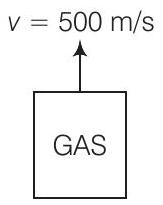
2. 1 mole of an ideal gas is contained in a cubical volume $V, A B C D E F G H$ at $300 K$ (figure). One face of the cube $(E F G H)$ is made up of a material which totally absorbs any gas molecule incident on it. At any given time,
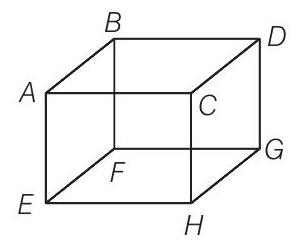
(a) the pressure on $E F G H$ would be zero
(b) the pressure on all the faces will the equal
(c) the pressure of $E F G H$ would be double the pressure on $A B C D$
(d) the pressure on $E F G H$ would be half that on $A B C D$
Show Answer
Answer (d) In an ideal gas, when a molecule collides elastically with a wall, the momentum transferred to each molecule will be twice the magnitude of its normal momentum. For the face $E F G H$, it transfers only half of that.3. Boyle’s law is applicable for an
(a) adiabatic process
(b) isothermal process
(c) isobaric process
(d) isochoric process
Show Answer
Answer
(b) Boyle’s law is applicable when temperature is constant
i.e.,
$p V=n R T=$ constant
$\Rightarrow$
$p V=$ constant (at constant temperature)
i.e.,
$p \propto \frac{1}{V}$
[where,$p=$ pressure, $V=$ volume $]$
So, this process can be called as isothermal process.
4. A cylinder containing an ideal gas is in vertical position and has a piston of mass $M$ that is able to move up or down without friction (figure). If the temperature is increased
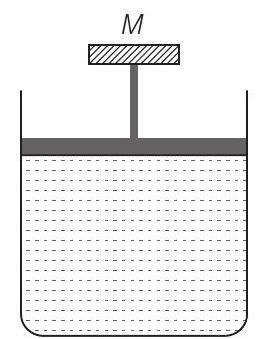
(a) both $p$ and $V$ of the gas will change
(b) only $p$ will increase according to Charles’ law
(c) $V$ will change but not $p$
(d) $p$ will change but not $V$
Show Answer
Answer (c) Consider the diagram where an ideal gas is contained in a cylinder, having a piston of mass $M$. Friction is absent.
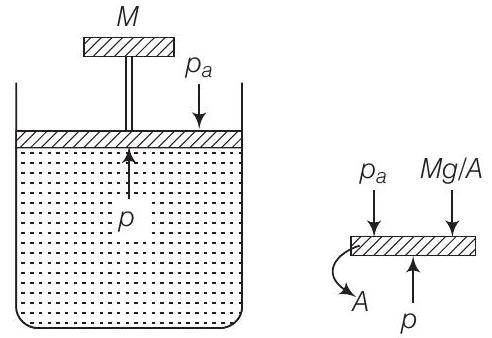
The pressure inside the gas will be
$$ p=p_{a}+M g / A $$
where, $p_{a}=$ atmospheric pressure
$A=$ area of cross-section of the piston.
$M g=$ weight of piston
Hence, $p=$ constant.
When temperature increases
as $\quad p V=n R T \Rightarrow$ volume $(V)$ increases at constant pressure.
5. Volume versus temperature graphs for a given mass of an ideal gas are shown in figure. At two different values of constant pressure. What can be inferred about relation between $p_1$ and $p_2$ ?
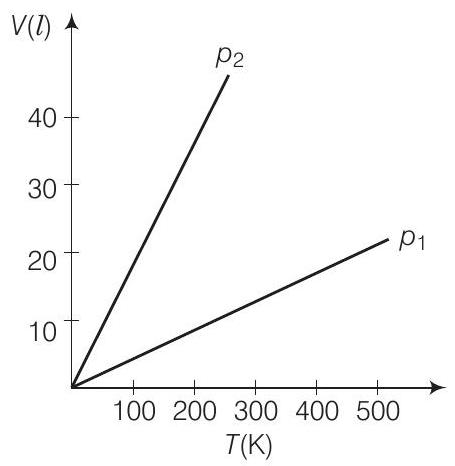
(a) $p_1>p_2$
(b) $p_1=p_2$
(c) $p_1<p_2$
(d) Data is insufficient
Show Answer
Thinking Process
To find the required relation, we have to consider slope of the $V-T$ graph. By ideal gas equation, the slope of $V-T$ curve is $V / T=n R / p$. This imply that greater the slope, smaller the pressure and vice-versa.
Answer (a) We know for an ideal gas,
$$ \begin{aligned} & p V=n R T \Rightarrow V=(\frac{n R}{p}) T \\ & \text { Slope of the } V-T \text { graph, } \quad m=\frac{d V}{d T}=\frac{n R}{p} \quad[m=\text { slope of } V-t \text { graph }] \\ & \Rightarrow \quad m \propto \frac{1}{p} \quad[\therefore n R=\text { constant }] \\ & \Rightarrow \quad p \propto \frac{1}{m} \\ & \text { hence, } \quad \frac{p_1}{p_2}=\frac{m_2}{m_1}<1 \\ & {[\begin{matrix} P=\text { pressure } \\ V=\text { volume } \\ n=\text { number of moles of gases } \\ R=\text { gas constant } \\ T=\text { temperature } \end{matrix} ]} \end{aligned} $$
where, $m_1$ is slope of the graph corresponding to $p_1$ and similarly $m_2$ is slope corresponding to $p_2$.
$$ \Rightarrow \quad p_2<p_1 \text { or } p_1>p_2 $$
6. 1 mole of $H_2$ gas is contained in a box of volume $V=1.00 m^{3}$ at $T=300 K$. The gas is heated to a temperature of $T=3000 K$ and the gas gets converted to a gas of hydrogen atoms. The final pressure would be (considering all gases to be ideal)
(a) same as the pressure initially
(b) 2 times the pressure initially
(c) 10 times the pressure initially
(d) 20 times the pressure initially
Show Answer
Answer (d) Consider the diagram, when the molecules breaks into atoms, the number of moles would become twice.
Now, by ideal gas equation
$$ \begin{matrix} P & =\text { Pressure of gas }, & & n=\text { Number of moles } \\ R & =\text { Gas constant }, & T=\text { Temperature } \\ p V & =n R T & & \end{matrix} $$
As volume $(V)$ of the container is constant.
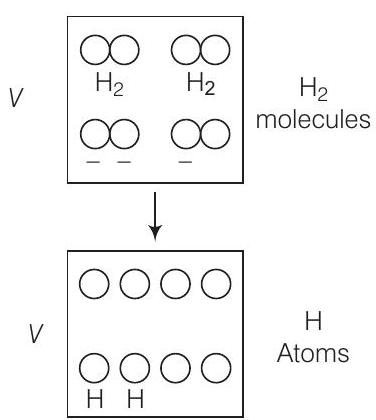
As gases breaks number of moles becomes twice of initial, so $n_2=2 n_1$
So,
$$ \begin{aligned} & p \propto n T \\ & \frac{p_2}{p_1}=\frac{n_2 T_2}{n_1 T_1}=\frac{(2 n_1)(3000)}{n_1(300)}=20 \end{aligned} $$
$\Rightarrow$
$$ p_2=20 p_1 $$
Hence, final pressure of the gas would be 20 times the pressure initially.
7. A vessel of volume $V$ contains a mixture of 1 mole of hydrogen and 1 mole oxygen (both considered as ideal). Let $f_1(v) d v$, denote the fraction of molecules with speed between $v$ and $(v+d v)$ with $f_2(v) d v$, similarly for oxygen. Then,
(a) $f_1(v)+f_2(v)=f(v)$ obeys the Maxwell’s distribution law
(b) $f_1(v), f_2(v)$ will obey the Maxwell’s distribution law separately
(c) neither $f_1(v)$, nor $f_2(v)$ will obey the Maxwell’s distribution law
(d) $f_2(v)$ and $f_1(v)$ will be the same
Show Answer
Answer (b) For a function $f(v)$, the number of molecules $n=f(v)$, which are having speeds between $v$ and $v+d v$.
For each function $f_1(v)$ and $f_2(v)$, $n$ will be different, hence each function $f_1(v)$ and $f_2(v)$ will obey the Maxwell’s distribution law separately.
8. An inflated rubber balloon contains one mole of an ideal gas, has a pressure $p$, volume $V$ and temperature $T$. If the temperature rises to $1.1 T$, and the volume is increased to $1.05 V$, the final pressure will be
(a) $1.1 p$
(b) $p$
(c) less than $p$
(d) between $p$ and 1.1
Show Answer
Answer (d) We know for an ideal gas, $p V=n R T$ (Ideal gas equation)
$$ \Rightarrow \quad \begin{aligned} n & =\text { Number of moles, } p=\text { Pressure, } V=\text { Volume } \\ R & =\text { Gas constant, } \quad T=\text { Temperature } \\ & =\frac{p V}{R T} \end{aligned} $$
As number of moles of the gas remains fixed, hence, we can write
$$ \begin{matrix} \frac{p_1 V_1}{R T_1} & =\frac{p_2 V_2}{R T_2} & \\ \Rightarrow \quad p_2 & =(p_1 V_1)(\frac{T_2}{V_2 T_1}) & \\ & =\frac{(p)(V)(1.1 T)}{(1.05) V(T)} \quad[\begin{matrix} p_1=p \\ V_2=1.05 V \text { and } T_2=1.1 T \end{matrix} ] \\ & =p \times(\frac{1.1}{1.05}) & \\ & =p(1.0476) \approx 1.05 p \end{matrix} $$
Hence, final pressure $p_2$ lies between $p$ and $1.1 p$.
Multiple Choice Questions (More Than One Options)
9. A B C D E F G H is a hollow cube made of an insulator (figure) face $A B C D$ has positive charge on it. Inside the cube, we have ionised hydrogen.
The usual kinetic theory expression for pressure
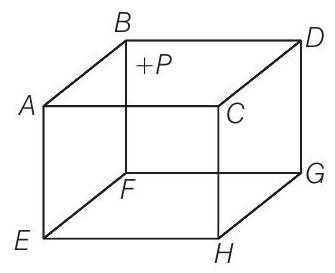
(a) will be valid
(b) will not be valid, since the ions would experience forces other than due to collisions with the walls
(c) will not be valid, since collisions with walls would not be elastic
(d) will not be valid because isotropy is lost
Show Answer
Thinking Process
As ionised hydrogen is present inside the cube, they are having charge. Now, due to presence of positive charge on the surface $A B C D$ hydrogen ions would experience forces of electrostatic nature.
Answer $(b, d)$
Due to presence of external positive charge on the face $A B C D$. The usual expression for pressure on the basis of kinetic theory will not be valid as ions would also experience electrostatic forces other than the forces due to collisions with the walls of the container. Due to presence of positive charge the isotropy is also lost.
10. Diatomic molecules like hydrogen have energies due to both translational as well as rotational motion. From the equation in kinetic theory $p V=\frac{2}{3} E, E$ is
(a) the total energy per unit volume
(b) only the translational part of energy because rotational energy is very small compared to the translational energy
(c) only the translational part of the energy because during collisions with the wall pressure relates to change in linear momentum
(d) the translational part of the energy because rotational energies of molecules can be of either sign and its average over all the molecules is zero
Show Answer
Answer (c) According to kinetic theory, we assume the walls only exert perpendicular forces on molecules. They do not exert any parallel force, hence there will not be any type of rotation present.
The wall produces only change in translational motion.
Hence, in the equation
$$ p V=\frac{2}{3} E $$
$$\left[\begin{array}{c} \text { where } P=\text { pressure } \ V=\text { volume } \end{array}\right]$$
$E$ is representing only translational part of energy.
11. In a diatomic molecule, the rotational energy at a given temperature
(a) obeys Maxwell’s distribution
(b) have the same value for all molecules
(c) equals the translational kinetic energy for each molecule
(d) is (2/3)rd the translational kinetic energy for each molecule
Show Answer
Answer $(a, d)$
Consider a diatomic molecule as shown in the diagram.
The total energy associated with the molecule is
$$ E=\frac{1}{2} m v_x^{2}+\frac{1}{2} m v_y^{2}+\frac{1}{2} m v_z^{2}+\frac{1}{2} I_{x} \omega_x^{2}+\frac{1}{2} I_{y} \omega_y^{2} $$
This above expression contains translational kinetic energy $(\frac{1}{2} m v^{2})$ corresponding to velocity in each $x, y$ and $z$-directions as well as rotational $KE(\frac{1}{2} I \omega^{2})$ associated with axis of rotations $x$ and $y$.
The number of independent terms in the above expression is 5.
As we can predict velocities of molecules by Maxwell’s distribution, hence the above expression also obeys Maxwell’s distribution.
$\because 2$ rotational and 3 translational energies are associated with each molecule.
$\therefore$ Rotational energy at a given temperature is $(\frac{2}{3})$ rd of translational KE of each molecule.
12. Which of the following diagrams (figure) depicts ideal gas behaviour?

Show Answer
Answer
$(a, c)$
We know that ideal gas equation is
$$ p V=n R T $$
(a) When pressure, $p=$ constant From (i) volume $V \propto$ Temperature $T$
(b) When $T$ = constant
From (i) $p V=$ constant
So, the graph is rectangular hyperbola.
(c) When $V=$ constant.
From (i) $p \propto T$
So, the graph is straight line passes through the origin.
(d) From (i) $p V \propto T$
$\Rightarrow \quad \frac{p V}{T}=$ constant
$\Rightarrow$ So, the graph hence, through origin.
So, (d) is not correct.
13. When an ideal gas is compressed adiabatically, its temperature rises the molecules on the average have more kinetic energy than before. The kinetic energy increases,
(a) because of collisions with moving parts of the wall only
(b) because of collisions with the entire wall
(c) because the molecules gets accelerated in their motion inside the volume
(d) because of redistribution of energy amongest the molecules
Show Answer
Thinking Process
The elastic collisions of the molecules with a moving part of two system increases their energy.
Answer (a) When the gas is compressed adiabatically, the total work done on the gas increases its internal energy which in turn increase the KE of gas molecules and hence, the collisions between molecules also increases.
Very Short Answer Type Questions
14. Calculate the number of atoms in $39.4 g$ gold. Molar mass of gold is $197 g mole^{-1}$.
Show Answer
Answer We know that,
$$ \text { Molar mass }=\text { Mass of Avogadro’s number of atoms (Molecules). } $$
$$ =6.023 \times 10^{23} \text { atoms } . $$
Given, $\quad$ molar mass of gold $=197 g / mol$
Now,
$\therefore \quad 197 g$ of gold contains $=6.023 \times 10^{23}$ atoms
$\therefore \quad 1 g$ of gold contain $=\frac{6.023 \times 10^{23}}{197}$ atoms
$\therefore \quad 39.4 g$ of gold contains $=\frac{6.023 \times 10^{23} \times 39.4}{197} \Rightarrow 1.20 \times 10^{23}$ atoms .
15. The volume of a given mass of a gas at $27^{\circ} C, 1 atm$ is $100 cc$. What will be its volume at $327^{\circ} C$ ?
Show Answer
Answer We have to convert the given temperatures in kelvin . If pressure of a given mass of the gas is kept constant, then
$$ \begin{aligned} & V \propto T \\ & \Rightarrow \quad \frac{V}{T}=\text { constant } \quad[\begin{matrix} V=\text { Volume of gas } \\ T=\text { Temperature of gas } \end{matrix} ] \\ & \Rightarrow \quad \frac{V_1}{T_1}=\frac{V_2}{T_2} \\ & \Rightarrow \quad V_2=V_1(\frac{T_2}{T_1}) \\ & T_1=273+27=300 K \\ & T_2=273+327=600 K \\ & \text { But } \quad V_1=100 cc \\ & V_2=V_1(\frac{600}{300}) \\ & V_2=2 V_1 \\ & V_2=2 \times 100=200 cc \end{aligned} $$
Note To apply ideal gas equation, we must convert the given temperature in kelvin.
16. The molecules of a given mass of a gas have root mean square speeds of $100 ms^{-1}$ at $27^{\circ} C$ and 1.00 atmospheric pressure. What will be the root mean square speeds of the molecules of the gas at $127^{\circ} C$ and 2.0 atmospheric pressure?
Show Answer
Answer We know that for a given mass of a gas
$$ v_{rms}=\sqrt{\frac{3 R T}{M}} $$
where, $R$ is gas constant
$T$ is temperature in kelvin
$M$ is molar mass of the gas.
Clearly,
$$ V_{rms} \propto \sqrt{T} $$
As $R, M$ are constants,
$ \frac{(v _{rms})_1}{(v _{rms})_2} $= $\sqrt \frac{T_1}{T_2} $
Given,
$\therefore$ From Eq. (i)
$(v_{\text {rms }})_1=100 m / s $
$ T_1=27^{\circ} C=27+273=300 K $
$ T_2=127^{\circ} C=127+273=400 K$
from eq (i)
$ \frac {100}{(v_{rms})_2}$ = $ \sqrt \frac{300}{400}$ = $ \frac{\sqrt 3}{2}$
$$ \Rightarrow \quad(v_{rms})_2=\frac{2 \times 100}{\sqrt{3}}=\frac{200}{\sqrt{3}} m / s $$
17. Two molecules of a gas have speeds of $9 \times 10^{6} ms^{-1}$ and $1 \times 10^{6} ms^{-1}$, respectively. What is the root mean square speed of these molecules.
Show Answer
Answer For $n$-molecules, we know that
$$ v_{rms}=\sqrt{\frac{v_1^{2}+v_2^{2}+v_3^{2}+\ldots \ldots+v_n^{2}}{n}} \quad[\begin{matrix} v_{r m s}=\text { root mean } \\ \text { square velocity } \end{matrix} ] $$
where $v_1, v_2, v_3 \ldots \ldots . . v_{n}$ are individual velocities of $n$-molecules of the gas.
For two molecules,
Given,
$$ v_{r m s}=\sqrt{\frac{v_1^{2}+v_2^{2}}{2}} \quad[v_1, v_2, v_3 \ldots \ldots \ldots . . v_{n} \text { are individual velocity }] $$
and
$$ v_1=9 \times 10^{6} m / s $$
$$ \begin{aligned} v_2 & =1 \times 10^{6} m / s \\ v_{r m s} & =\sqrt{\frac{(9 \times 10^{6})^{2}+(1 \times 10^{6})^{2}}{2}} \\ & =\sqrt{\frac{81 \times 10^{12}+1 \times 10^{12}}{2}} \\ & =\sqrt{\frac{(81+1) \times 10^{12}}{2}} \\ & =\sqrt{\frac{82 \times 10^{12}}{2}} \\ & =\sqrt{41} \times 10^{6} m / s \end{aligned} $$
18. A gas mixture consists of 2.0 moles of oxygen and 4.0 moles of neon at temperature $T$. Neglecting all vibrational modes, calculate the total internal energy of the system. (0xygen has two rotational modes.)
Show Answer
Thinking Process
To find exact value of total energy for a given molecule of a gas, we must know the number of degree of freedom associated with the molecules of the gas.
Answer $O_2$ is a diatomic gas having 5 degrees of freedom.
Energy (total internal) per mole of the gas $=\frac{5}{2} R T$
$[\begin{matrix} R=\text { Universal gas constant } \\ T=\text { temperature }\end{matrix} ]$
For 2 moles of the gas total internal energy $=2 \times \frac{5}{2} R T=5 R T$
Neon (Ne) is a monoatomic gas having 3 degrees of freedom.
$\therefore$ Energy per mole $=\frac{3}{2} R T$
We have 4 moles of $Ne$.
Hence,
$$ \text { Energy }=4 \times \frac{3}{2} R T=6 R T $$
$$ \begin{aligned} \text { Total energy } & =5 R T+6 R T \\ & =11 R T \end{aligned} $$
19. Calculate the ratio of the mean free paths of the molecules of two gases having molecular diameters $1 \AA$ and $2 \AA$. The gases may be considered under identical conditions of temperature, pressure and volume.
Show Answer
Answer Mean free path of a molecule is given by
$$ l=\frac{1}{\sqrt{2} d^{2} n} $$
where, $n=$ number of molecules/ volume
$d=$ diameter of the molecule
Now, we can write $l \propto \frac{1}{d^{2}}$
Given,
$$ d_1=1 \AA, d_2=2 \AA $$
As
$\Rightarrow$ So,
$$ l_1 \propto \frac{1}{d_1^{2}} \text { and } l_2 \propto \frac{1}{d_2^{2}} $$
$\Rightarrow$ So,
$$ \frac{l_1}{l_2}=(\frac{d_2}{d_1})^{2}=(\frac{2}{1})^{2}=\frac{4}{1} $$
Hence,
$$ l_1: l_2=4: 1 $$
Short Answer Type Questions
20. The container shown in figure has two chambers, separated by a partition, of volumes $V_1=2.0 L$ and $V_2=3.0 L$. The chambers contain $\mu_1=4.0$ and $\mu_2=5.0$ mole of a gas at pressures $p_1=1.00 atm$ and
| $p _1, V _1$ | $p _2, V _2$ |
|---|---|
| $\mu _1$ | $\mu _2$ |
$p_2=2.00 atm$. Calculate the pressure after the partition is removed and the mixture attains equilibrium.
| $V _1, \mu _1$, | $V _2$ |
|---|---|
| $p _1$ | $\mu _2$, |
| $p _2$, |
Show Answer
Answer Consider the diagram,
Given,
$$ \begin{aligned} V_1 & =2.0 L, V_2=3.0 L \\ \mu_1 & =4.0 mol, \mu_2=5.0 mol \\ p_1 & =1.00 atm, p_2=2.00 atm \end{aligned} $$
For chamber 1, $p_1, V_1=\mu_1 R T_1$
For chamber 2, $p_2, V_2=\mu_2 R T_2$
When the partition is removed the gases get mixed without any loss of energy. The mixture now attains a common equilibrium pressure and the total volume of the system is sum of the volume of individual chambers $V_1$ and $V_2$.
So,
From kinetic theory of gases,
For $l$ mole $\quad p V=\frac{2}{3} E$ $[\begin{matrix} E=\underset{\text { kinetic energy }}{\text { translational }}\end{matrix} ]$
For $\mu_1$ moles,
$$ p_1 V_1=\frac{2}{3} \mu_1 E_1 $$
For $\mu_2$ moles,
$$ p_2 V_2=\frac{2}{3} \mu_2 E_2 $$
Total energy is
$$ (\mu_1 E_1+\mu_2 E_2)=\frac{3}{2}(p_1 V_1+p_2 V_2) $$
From the abvne relation, $\quad p V=\frac{2}{3} E_{\text {total }}=\frac{2}{3} \mu E_{\text {per mole }}$
$$ \begin{aligned} p(V_1+V_2) & =\frac{2}{3} \times \frac{3}{2}(p_1 V_1+p_2 V_2) \\ p & =\frac{p_1 V_1+p_2 V_2}{V_1+V_2} \\ & =(\frac{1.00 \times 2.0+2.00 \times 3.0}{2.0+3.0}) atm \\ & =\frac{8.0}{5.0}=1.60 atm \end{aligned} $$
21. A gas mixture consists of molecules of $A, B$ and $C$ with masses $m_{A}>m_{B}>m_{C}$. Rank the three types of molecules in decreasing order of (a) average KE (b) rms speeds.
Show Answer
Answer (a) The average KE will be the same, as conditions of temperature and pressure are the same.
Now as,
$$ \begin{aligned} v_{rms} & =\sqrt{\frac{3 p V}{M}}=\sqrt{\frac{3 R T}{M}} \\ & =\sqrt{\frac{3 R T}{m N}}=\sqrt{\frac{3 k T}{m}} \end{aligned} $$
where,
Clearly,
$$ \begin{aligned} M & =\text { molar mass of the gas } \\ m & =\text { mass of each molecular of the gas } \\ R & =\text { gas constant } \end{aligned} $$
(b) As k = Boltzmann constant
$$ v_{rms} \propto \sqrt{\frac{1}{m}} $$
$T$ = absolute temperature (same for all)
But $m_{A}>m_{B}>m_{C}$
$(v _ {rms})_A < (v _ {rms})_B < (v _ {rms})_C $
OR
$(v _ {rms})_C > (v _ {rms})_B > (v _ {rms})_A$
22. We have $0.5 g$ of hydrogen gas in a cubic chamber of size $3 cm$ kept at NTP. The gas in the chamber is compressed keeping the temperature constant till a final pressure of $100 atm$. Is one justified in assuming the ideal gas law, in the final state? (Hydrogen molecules can be consider as spheres of radius $1 \AA$ ).
Show Answer
Thinking Process
For justification of assuming the ideal gas law, the molecular volume and the volume occupied of the ideal gas is compared. If both matches, then law holds good otherwise not.
Answer Assuming hydrogen molecules as spheres of radius $1 \AA$.
So, $r=1 \AA=$ radius.
The volume of hydrogen molecules $=\frac{4}{3} \pi r^{3}$
$$ \begin{aligned} & =\frac{4}{3}(3.14)(10^{-10})^{3} \\ & \approx 4 \times 10^{-30} m^{3} \\ \text { Number of moles of } H_2 & =\frac{\text { Mass }}{\text { Molecular mass }} \\ & =\frac{0.5}{2}=0.25 \end{aligned} $$
Molecules of $H_2$ present $=$ Number of moles of $H_2$ present $\times 6.023 \times 10^{23}$
$$ =0.25 \times 6.023 \times 10^{23} $$
$\therefore$ Volume of molecules present $=$ Molecules number $\times$ volume of each molecule
$$ \begin{aligned} & =0.25 \times 6.023 \times 10^{23} \times 4 \times 10^{-30} \\ & =6.023 \times 10^{23} \times 10^{-30} \\ & \approx 6 \times 10^{-7} m^{3} \end{aligned} $$
Now, if ideal gas law is considered to be constant.
$$ \begin{aligned} p_{i} V_{i} & =p_{f} V_{f} \\ V_{f} & =(\frac{p_{i}}{p_{f}}) V_{i}=(\frac{1}{100})(3 \times 10^{-2})^{3} \\ & =\frac{27 \times 10^{-6}}{10^{2}} \\ & =2.7 \times 10^{-7} m^{3} \end{aligned} $$
Hence, on compression the volume of the gas is of the order of the molecular volume [form Eq.(i) and Eq.(ii)]. The intermolecular forces will play role and the gas will deviate from ideal gas behaviour.
23. When air is pumped into a cycle tyre the volume and pressure of the air in the tyre both are increased. What about Boyle’s law in this case?
Show Answer
Answer When air is pumped, more molecules are pumped and Boyle’s law is stated for situation where number of molecules remains constant.
In this case, as the number of air molecules keep increasing. Hence, this is a case of variable mass. Boyle’s law (and even Charle’s law) is only applicable in situations, where number of gas molecules remains fixed.
Hence, in this case Boyle’s law is not applicable.
24. A balloon has 5.0 mole of helium at $7^{\circ} C$. Calculate
(a) the number of atoms of helium in the balloon.
(b) the total internal energy of the system.
Show Answer
Thinking Process
Energy associated with a monoatomic molecule is $\frac{3}{2} k T$.
Answer Given, number of moles of helium $=5$
$$ T=7^{\circ} C=7+273=280 K $$
(a) Hence, number of atoms (He is monoatomic)
$$ \begin{aligned} & =\text { Number of moles } \times \text { Avogadro’s number } \\ & =5 \times 6.023 \times 10^{23} \\ & =30.015 \times 10^{23} \\ & =3.0 \times 10^{24} \text { atoms } \end{aligned} $$
(b) Now, average kinetic energy per molecule $=\frac{3}{2} k_{B} T$
Here, $k_{B}=$ Boltzmann constant.
(It has only 3 degrees of freedom)
$\therefore$ Total energy of all the atoms
$$ \begin{aligned} & =\text { Total internal energy } \\ & =\frac{3}{2} k_{b} T \times \text { number of atoms } \\ & =\frac{3}{2} \times 1.38 \times 10^{-23} \times 280 \times 3.0 \times 10^{24} \\ & =1.74 \times 10^{4} J \end{aligned} $$
25. Calculate the number of degrees of freedom of molecules of hydrogen in 1 cc of hydrogen gas at NTP.
Show Answer
Thinking Process
Total number of degrees of freedom in a thermodynamical system $=$ number of degrees of freedom associated per molecule × number of molecules.
Answer As given molecules are of hydrogen.
$\therefore$ Volume occupied by 1 mole
$$ \begin{aligned} & =1 \text { mole of the gas at NTP } \\ & =22400 mL=22400 cc \end{aligned} $$
$\therefore$ Number of molecules in $1 cc$ of hydrogen
$$ =\frac{6.023 \times 10^{23}}{22400}=2.688 \times 10^{19} $$
$H_2$ is a diatomic gas, having a total of 5 degrees of freedom (3 translational +2 rotational)
$\therefore$ Total degrees of freedom possesed by all the molecules
$$ \begin{aligned} & =5 \times 2.688 \times 10^{19} \\ & =1.344 \times 10^{20} \end{aligned} $$
Note Any ideal gas has a molar volume of $22400 mL$ (cc) at NTP.
26. An insulated container containing monoatomic gas of molar mass $m$ is moving with a velocity $v_{o}$. If the container is suddenly stopped, find the change in temperature.
Show Answer
Thinking Process
As the container is suddenly stopped there is no time for exchange of heat in the process.
Answer According to kinetic interpretation of temperature, absolute temperature of a given sample of a gas is proportional to the total translational kinetic energy of its molecules.
Hence, any change in absolute temperature of a gas will contribute to corresponding change in translational KE and vice-versa.
Assuming $n=$ number of moles.
Given, $\quad m=$ molar mass of the gas.
When, the container stops, its total KE is transferred to gas molecules in the form of translational KE, thereby increasing the absolute temperature.
If $\Delta T$ = change in absolute temperature.
Then, $KE$ of molecules due to velocity $v_0, KE=\frac{1}{2}(m n) v_0^{2}$
Increase in translational $K E=n \frac{3}{2} R(\Delta T)$
According to kinetic theory Eqs. (i) and (ii) are equal
$$ \begin{matrix} \Rightarrow & & \frac{1}{2}(m n) v_0^{2} & =n \frac{3}{2} R(\Delta T) \\ \Rightarrow & & \Delta T & =\frac{(m n) v_0^{2}}{3 n R} \\ \Rightarrow & & n 3 R(\Delta T) \\ \Rightarrow & \Delta T & =\frac{m v_0^{2}}{3 R} \end{matrix} $$
Long Answer Type Questions
27. Explain why
(a) there is no atmosphere on moon
(b) there is fall in temperature with altitude
Show Answer
Answer (a) The moon has small gravitational force (pull) and hence, the escape velocity is small. The value of escape velocity for the moon is $4.6 km / s$.
As the moon is in the proximity of the earth as seen from the sun, the moon has the same amount of heat per unit area as that of the earth.
The air molecules have large range of speeds. Even though the rms speed of the air molecules is smaller than the escape velocity on the moon, a significant number of molecules have speed greater than escape velocity and they escape.
Now, rest of the molecules arrange the speed distribution for the equilibrium temperature. Again a significant number of molecules escape as their speed exceed escape speed. Hence, over a long time the moon has lost most of its atmosphere.
$$ \begin{aligned} \text { At } 300 K, v_{rms}=\sqrt{\frac{3 kT}{m}} & =\sqrt{\frac{3 \times 1.38 \times 10^{-23} \times 300}{7.3 \times 10^{-26}}}=1.7 km / s \\ v_{es} \text { for moon } & =4.6 km / s \quad \quad[v_{es}=\text { escape velocity }] \end{aligned} $$
(b) As the molecules move higher; their potential energy increases and hence, kinetic energy decreases and hence, temperature reduces.
At greater height more volume is available and gas expands and hence, some cooling takes place.
Note We should not relate temperature directly with potential energy. It is directly related with kinetic energy of the molecules.
28. Consider an ideal gas with following distribution of speeds.
| Speed $(m / s)$ | % of molecules |
|---|---|
| 200 | 10 |
| 400 | 20 |
| 600 | 40 |
| 800 | 20 |
| 1000 | 10 |
(a) Calculate $v_{\text {rms }}$ and hence $T .(m=3.0 \times 10^{-26} kg)$
(b) If all the molecules with speed $1000 m / s$ escape from the system, calculate new $v_{\text {rms }}$ and hence $T$.
Show Answer
Thinking Process
In this problem, it is shown that cooling takes place after evaporation.
Answer (a) We know that
$$ v_rms^{2}=\frac{\sum_{i} n_{i} v_i^{2}}{\sum n_{i}} $$
This is the rms speed for all molecules collectively.
$$ \text { Now, } \begin{aligned} v_{\text {rms }} & =(\frac{\sum_{i} n_{i} v_i^{2}}{\sum n_{i}})^{\frac{1}{2}} \\ & =\sqrt{\frac{n_1 v_1^{2}+n_2 v_2^{2}+n_3 v_3^{2}+\ldots \ldots \ldots+n_{n} v_n^{2}}{n_1+n_2+n_3+\ldots \ldots . .+n_{n}}} \\ & =\sqrt{\frac{n_1 v_1^{2}+n_2 v_2^{2}+n_3 v_3^{2}+n_4 v_4^{2}+n_5 v_5^{2}}{n_1+n_2+n_3+n_4+n_5}} \\ & =\sqrt{\frac{.10 \times(200)^{2}+20 \times(400)^{2}+40 \times 600)^{2}+20 \times(800)^{2}+10 \times(1000)^{2}}{100}} \\ & =\sqrt{1000 \times(4+32+144+128+100)} \\ & =\sqrt{408 \times 1000} \approx 639 m / s . \end{aligned} $$
Now, according to kinetic theory of gasses
$$ \begin{aligned} \frac{1}{2} m v_rms^{2} & =\frac{3}{2} k_{B} T \quad[\begin{matrix} K_{B}=\text { Boltzmann constant } \\ m=\text { mass of gaseous molecules } \end{matrix} ] \\ T=\frac{1}{3} \frac{m v_rms^{2}}{k_{B}} & =\frac{1}{3} \times \frac{3.0 \times 10^{-26} \times 4.08 \times 10^{5}}{1.38 \times 10^{-23}} \\ & =2.96 \times 10^{2} K=296 K \end{aligned} $$
(b) If all the molecules with speed $1000 m / s$ escape, then
$$ \begin{aligned} v_rms^{2} & =\frac{10 \times(200)^{2}+20 \times(400)^{2}+40 \times(600)^{2}+20 \times(800)^{2}}{90} \\ & =\frac{10 \times 100^{2} \times(1 \times 4+2 \times 16+4 \times 36+2 \times 64)}{90} \\ & =10000 \times \frac{308}{9}=342 \times 1000 m^{2} / s^{2} \\ \text { Again } \quad v_{rms} & =584 m / s \\ T & =\frac{1}{3} \frac{mv rms^{2}}{k} \\ & =\frac{1}{3} \times \frac{3 \times 10^{-26} \times 3.42 \times 10^{5}}{1.38 \times 10^{-23}} \\ & =2.478 \times 10^{2} \\ & =247.8 \approx 248 K \end{aligned} $$
Note After escaping of molecules with speed of $1000 m / s$, the temperature in part (b) is $248 K$ whereas in part (a) before escaping of molecules the temperature was 296 K. Thus, evaporation facilitates cooling.
29. Ten small planes are flying at a speed of $150 km / h$ in total darkness in an air space that is $20 \times 20 \times 1.5 km^{3}$ in volume. You are in one of the planes, flying at random within this space with no way of knowing where the other planes are. On the average about how long a time will elapse between near collision with your plane. Assume for this rough computation that a saftey region around the plane can be approximated by a sphere of radius $10 m$.
Show Answer
Thinking Process
To solve this problem, we have to consider the relaxation time as well as mean free path.
Answer The situation can be considered as the time of relaxation, based on kinetic theory of gases. Mean free path is the distance between two successive collisions, which we will consider here as the distance travelled by the plane before it just avoids the collision safe radius is equivalent to radius of the atom.
Hence, the required time
$$ \begin{aligned} t=\frac{l}{V}, l=\text { mean free path } & =\frac{1}{\sqrt{2} \pi d^{2} n}, n=\text { number density }=\frac{N}{V} \\ n & =\frac{\text { Number of aeroplanes }(N)}{\text { Volume }(V)} \\ & =\frac{10}{20 \times 20 \times 1.5}=0.0167 km^{-3} \\ t & =\frac{1}{\sqrt{2} \pi d^{2}(N / V)} \times \frac{1}{V} \quad[V=\text { velocity of aeroplane }] \end{aligned} $$
By putting the given data,
$$ \begin{aligned} t & =\frac{1}{\sqrt{2} \times 3.14 \times(20)^{2} \times 0.0167 \times 10^{-6} \times 150} \\ & =\frac{10^{6}}{1776.25 \times 2.505} \\ & =\frac{10^{6}}{4449.5}=224.74 h \\ & \approx 225 h \end{aligned} $$
30. A box of $1.00 m^{3}$ is filled with nitrogen at $1.50 atm$ at $300 K$. The box has a hole of an area $0.010 mm^{2}$. How much time is required for the pressure to reduce by $0.10 atm$, if the pressure outside is $1 atm$.
Show Answer
Answer Given, volume of the box, $V=1.00 m^{3}$
$$ \begin{gathered} \text { Area }=a=0.010 mm^{2} \\ =8.01 \times 10^{-6} m^{2} \\ =10^{-8} m^{2} \end{gathered} $$
Temperature outside $=$ Temperature inside
Initial pressure inside the $b o x=1.50 atm$.
Final pressure inside the $box=0.10 atm$.
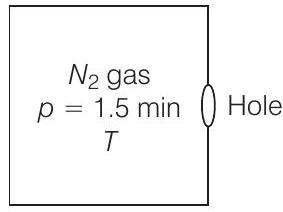
$p_{\text {outside }}=1$ atm Assuming,
$v_{i x}=$ Speed of nitrogen molecule inside the box along $x$-direction.
$n_{i}=$ Number of molecules per unit volume in a time interval of $\Delta T$, all the particles at a distance $(v_{i x} \Delta t)$ will collide the hole and the wall, the particle colliding along the hole will escape out reducing the pressure in the box.
Let area of the wall, number of particles colliding in time
$$ \Delta t=\frac{1}{2} n_{i}(v_{i x} \Delta t) A $$
$\frac{1}{2}$ is the factor because all the particles along $x$-direction are behaving randomly. Hence, half of these are colliding against the walls on either side.
Inside the box, $\quad v_{i x}^{2}+v_{i y}^{2}+v_{i z}^{2}=v_{\text {rms }}^{2}$
$$ .\begin{matrix} \therefore & v_{i x}^{2}=\frac{v_rms^{2}}{3} \\ \text { or } & \frac{1}{2} m v_rms^{2} & =\frac{3}{2} k_{B} T \\ \Rightarrow & v_rms^{2} & =\frac{3 k_{B} T}{m} \end{matrix} ] $$
[According to kinetic theory of gases]
Now
$$ v_{i x}^{2}=\frac{v_rms^{2}}{3}=\frac{1}{3} \times \frac{3 k_{B} T}{m} $$
or
$$ v_{i x}^{2}=\frac{k_{B} T}{m} $$
$\therefore$ Number of particles colliding in time
$$ \Delta t=\frac{1}{2} n_{i} \sqrt{\frac{k_{B} T}{m}} \Delta t A $$
If particles collide along hole, they move out. Similarly, outer particles colliding along hole will move in.
If $a=$ area of hole
Then, net particle flow in time $\Delta t=\frac{1}{2}(n_1-n_2) \sqrt{\frac{k_{B} T}{m}} \Delta t a$
[Temperatures inside and outside the box are equal]
$$ p V=\mu R T \Rightarrow \mu=\frac{p V}{R T} $$
Let $n=$ number density of nitrogen $=\frac{\mu N_{A}}{V}=\frac{p N_{A}}{R T}$
Let $N_{A}=$ Avogardro’s number
If after time $\tau$ pressure inside changes from $p$ to $p_1^{1}$
$$ \therefore \quad \quad n_1^{\prime}=\frac{V N_{A}}{R T} $$
Now, number of molecules gone out $=n_1 V-n_1^{\prime} V$
$ =\frac{1}{2}(n_1-n_2) \sqrt{\frac{k_{B} T}{m}} \tau a $
$\therefore \frac{p_1 N_{A}}{R T} V-\frac{v N_{A}}{R T} V =\frac{1}{2}(p_1-p_2) \frac{N_{A}}{R T} \sqrt{\frac{k_{B} T}{m}} \tau a $
$ \text { or } \frac{p_1 N_{A}}{R T} V-\frac{v N_{A}}{R T} V =\frac{1}{2}(p_1-p_2) \frac{N_{A}}{R T} \sqrt{\frac{k_{B} T}{m}} \tau a $
$ \therefore \tau =2(\frac{p_1-p v_1}{p_1-p_2}) \frac{V}{a} \sqrt{\frac{m}{k_{B} T}}$
Putting the values from the data given,
$$ \begin{aligned} \tau & =2(\frac{1.5-1.4}{1.5-1.0}) \frac{1 \times 1.00}{0.01 \times 10^{-6}} \sqrt{\frac{46.7 \times 10^{-27}}{1.38 \times 10^{-23} \times 300}} \\ & =2(\frac{0.1}{0.5}) \frac{1}{10^{-8}} \sqrt{\frac{4.7}{1.38 \times 3} \times 10^{-6}} \\ & =2(\frac{1}{5}) 1 \times 10^{8} \times 10^{-3} \times \sqrt{\frac{46.7}{4.14}}=\frac{2}{5} \times 10^{5} \sqrt{\frac{45.7}{4.14}} \\ & =\frac{2}{5} \times 10^{5} \sqrt{11.28} \\ & =\frac{2}{5} \times 3.358 \times 10^{5}=\frac{6.717}{5} \times 10^{5}=1.343 \times 10^{5} s \end{aligned} $$
31. Consider a rectangular block of wood moving with a velocity $v_0$ in a gas at temperature $T$ and mass density $\rho$. Assume the velocity is along $x$-axis and the area of cross-section of the block perpendicular to $v_0$ is $A$. Show that the drag force on the block is $4 r A v_0 \sqrt{\frac{k T}{m}}$, where, $m$ is the mass of the gas molecule.
Show Answer
Thinking Process
If a massive body is moving with respect to a lighter body with velocity $v+v_{o}$, then the lighter body suffers a change in momentum $2 m(v+v_0)$ which is transferred to the heavier body.
Answer Consider the diagram
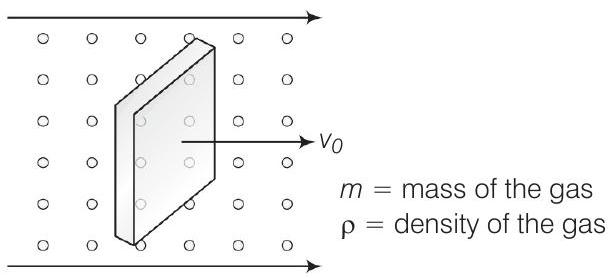
Let $n=$ number of molecules per unit volume
$v_{\text {rms }}=$ rms speed of the gas molecules
When block is moving with speed $v_0$, relative speed of molecules w.r.t. front face $=v+v_0$
Coming head on, momentum transferred to block per collision $=2 m(v+v_0)$,
where, $m=$ mass of molecule.
Number of collission in time $\Delta t=\frac{1}{2}(v+v_0) n \Delta t A$, where, $A=$ area of cross-section of block and factor of $1 / 2$ appears due to particles moving towards block.
$\therefore$ Momentum transferred in time $\Delta t=m(v+v_0)^{2} n A \Delta t$ from front surface.
Similarly, momentum transferred in time $\Delta t=m(v-v_0)^{2} n A \Delta t$ (from back surface)
$\therefore$ Net force
$$ \begin{aligned} (\text { drag force }) & =m n A[(v+v_0)^{2}-(v-v_0)^{2}] \\ & =m n A(4 v v_0)=(4 m n A v) v_0 \\ & =(4 \rho A v) v_0 \\ \text { ned } \quad \quad \rho & =\frac{m n}{v}=\frac{M}{V} \end{aligned} $$
where we have assumed
[from front]
If $v=$ velocity along $x$-axis
Then, we can write
$$ KE=\frac{1}{2} m v^{2}=\frac{1}{2} k_{B} T $$
$\Rightarrow$
$$ v=\sqrt{\frac{k_{B} T}{m}} $$
$[\begin{matrix} K_{B} & =\text { Boltzmann constant } \\ K E & =\text { Kinetic energy } \\ T & =\text { Temperature }\end{matrix} ]$
$\therefore$ From Eq. (i), $\quad$ Drag force $=(4 \rho A v) v_0=4 \rho A \sqrt{\frac{k_{B} T}{m}} v_0$.










